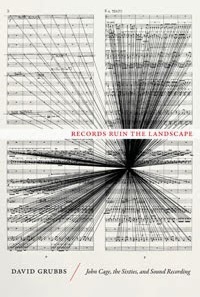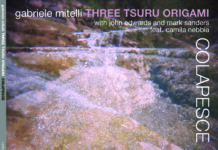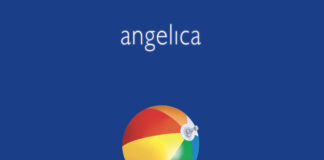1
In conversation with Daniel Charles, John Cage famously compared music recordings to postcards that ruin the landscape they purportedly depict. Hence the title of this engaging book by David Grubbs, a guitarist and composer probably best known as a founder of the punk band Squirrel Bait, and who now is an Associate Professor at Brooklyn College’s Conservatory of Music.
Grubbs sets out to show how differently the experimental music of the 1960s is experienced now, in the age of easily available recordings, compared to how it was experienced at the time it was created, when recordings were difficult to come by if indeed they were available at all. The central paradox—or contradiction, if the stronger term is preferred, as some experimental musicians of the time may well prefer it—that Grubbs explores is this: We are able to experience the experimental music of the 1960s by virtue of a seemingly ever-expanding set of available recordings, even though many of the composers and performers represented objected to having their music captured on recordings for one reason or another. And yet it is because of these recordings’ ability to communicate across time to new generations that experimental music as a field has grown.
It would have been difficult to foresee this in the 1960s, when these works were composed and performed and when the field of experimental music as we now recognize it was being formed. What is striking about that time is how little of the music was available to listeners through recordings. As Grubbs notes, Columbia Records’ Music of Our Time series, produced by composer David Berhman, and Mainstream Records’ Contemporary Sound Series, produced by composer Earle Brown, issued important experimental works between 1967 and 1973. But these series’ combined output represented a very small segment of the market for recorded music at the time, and the fact was that experimental music recordings were few and hard to get.
Grubbs amply demonstrates that many of the experimental composers and performers of the period objected to having their music known through recordings. Some felt that fixing a performance to be heard repeatedly and unvaryingly violated the spirit of spontaneity inherent in free improvisation, or contradicted the principle of compositional indeterminacy, which intended that realizations of the same composition vary from performance to performance. By capturing the performance the recording killed it and thus betrayed the experience. And yet it is also true that for the few who did have access to them, the recordings not only served to transmit news of a field undergoing great creative ferment, but even functioned as audio scores of sorts for those who wanted to listen and attempt to sound out the principles and processes behind the performances.
In this connection it is ironic to note, as Grubbs shows in a chapter on Cage as recording artist, that it was the availability of Cage’s early recordings, beginning with The 25-Year Retrospective Concert (1958), Indeterminacy (1959), and Cartridge Music and Variations II in the 1960s, that helped to establish Cage’s status as a leading figure in the field. Cage may have disliked these distracting “postcards,” but they did much to secure his reputation as a leading composer and theorist of experimental music. They also did much to shape the future of experimental music in his image, no matter how refracted or distorted recordings may have rendered that image. Recordings, in short, meant influence.
2
The situation now is far removed from what it was in the 1960s and early 1970s, as Grubbs illustrates. What was rare and provocative then has managed to stay provocative while no longer being rare. Archival recordings and reissues have become available on CD since the 1990s, and now with the broad distribution facilitated by the Internet experimental sound recordings of all sorts and vintages are ubiquitous for those who want them. The number of composers and performers working in the field of experimental music is also much larger than in the 1960s, at least in part because of the ability of recordings—the classic recordings of the time as well as contemporary recordings of new and current work—to impart vital information across space and time about how the music was and is done.
It is through this function as carriers and communicators of information that recordings have not only documented but also have helped constitute experimental music making. Listening to them isn’t just a passive experience but rather an active one involving interpretation of the sounds captured and perhaps an inference to some sense of what the composer or performer may have intended. It is as documents open to interpretation that recordings have—for better and for worse—played a significant role in defining the practices we recognize as belonging to the field of experimental music.
Like any human activity, experimental music exists in a field made up of characteristic practices, materials, norms, etc., that are dynamically interpreted by experimental composers and musicians and their audiences. Recordings, by documenting exemplary—and perhaps not so exemplary—performances, are repositories of relevant information that serve as more or less canonical objects of interpretation. In a sense they create a context for deriving meaning and practical knowledge within which not only listeners but also practitioners and potential practitioners are situated; by conveying news of the field they provide the basic information from which we develop expectations of what the music will sound like or how it will be performed. This is brought home even more dramatically when we consider that experimental music performances can now commonly be found in audio-visual format. With the data-rich dissemination made possible by broadband web connections, “recordings” now increasingly encompass not only sound recordings, but videos as well. Not only can we hear how it’s done, but we can see it as well.
It is hard not to conclude that recordings don’t kill experimental music so much as they help provide the means for its perpetuation and development. Recordings afford audiences the opportunity to explore it, understand or misunderstand it, to take it up and inevitably, to change it. It is this function that makes them attractive and objectionable at the same time. Attractive in that they transmit essential, albeit not exhaustive, information about the state of the field to practitioners, potential practitioners, and other interested people. Objectionable in that they do indeed isolate and immobilize a moment in a dynamic process, with all of the potential for distortion and misrepresentation that that involves.
In both their attractive and objectionable aspects, recordings reveal themselves to play an important role in what is, for lack of a more elegant term, the hermeneutics of experimental music. Recordings, no less than scores, personal instruction, attendance at performances or other forms of first-hand transmission, help constitute the field of experimental music by preserving examples of practices to be interpreted, emulated, accepted, rejected, and above all transformed by subsequent performers, composers and listeners. This is as true of the historic recordings of early experimental music as it is of the recorded documents of performances of more recent and contemporary experimental music. Experimental music is, at this point, a tradition of its own, and recordings are one important medium through which that tradition is handed down, assimilated and developed. In this sense recordings are, to borrow Pound’s dictum, news that stays news.







